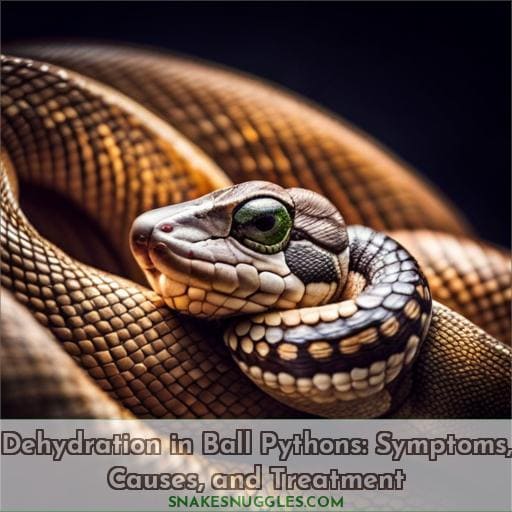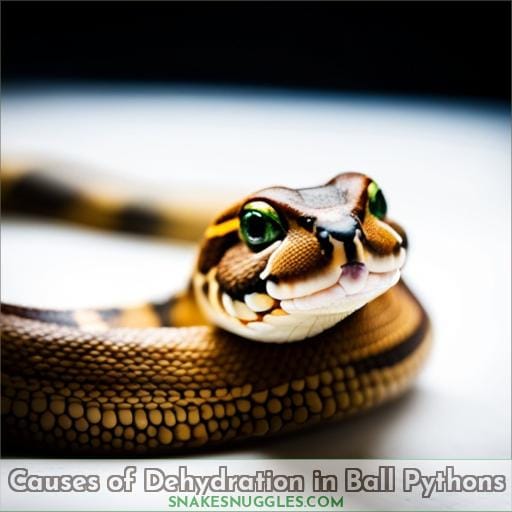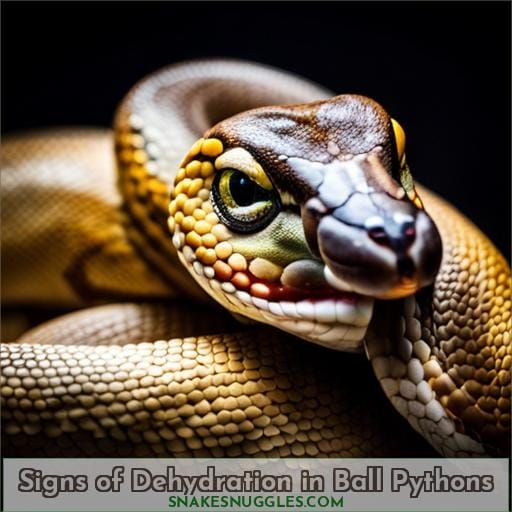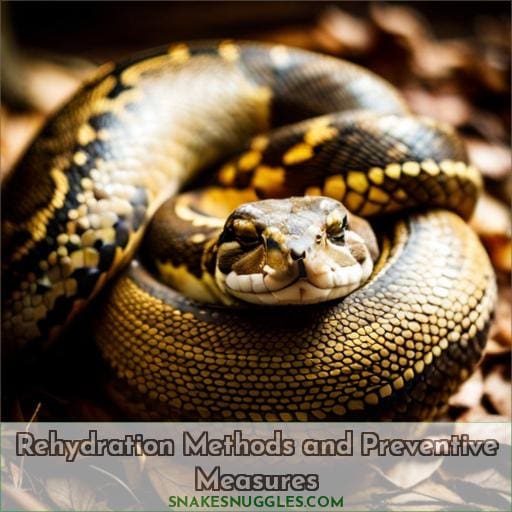This site is supported by our readers. We may earn a commission, at no cost to you, if you purchase through links.
 Imagine this: your beloved ball python showing signs of dehydration. As a responsible pet owner, it’s important to understand the symptoms, causes, and treatment options for dehydration in ball pythons.
Imagine this: your beloved ball python showing signs of dehydration. As a responsible pet owner, it’s important to understand the symptoms, causes, and treatment options for dehydration in ball pythons.
In this article on ‘Dehydration in Ball Pythons: Symptoms, Causes, and Treatment,’ we will delve into these details to help you ensure the well-being of your scaly friend.
Table Of Contents
- Key Takeaways
- Causes of Dehydration in Ball Pythons
- Signs of Dehydration in Ball Pythons
- Risks of Dehydration
- Duration Without Water
- Rehydration Methods and Preventive Measures
- Frequently Asked Questions (FAQs)
- How can I prevent dehydration in my ball python?
- Can dehydration in ball pythons be fatal?
- What are the long-term health consequences of dehydration in ball pythons?
- Are there any specific signs of dehydration in ball pythons that I should look out for?
- Is there a specific age range or size of ball python that is more susceptible to dehydration?
- Conclusion
Key Takeaways
- Dehydration in ball pythons can be caused by high temperatures, incorrect humidity levels, inadequate water supply, and parasitic infections.
- Symptoms of dehydration in ball pythons include dry inner mouth and tongue, food refusal, weakness, stuck shedding, and eye infections.
- Ball pythons can survive up to 12 days without water, but their health may start deteriorating after this point, and potential death could occur within a month of dehydration.
- To prevent dehydration in ball pythons, it is important to provide fresh drinking water in a dish accessible at all times, maintain humidity levels between 60-70%, and monitor temperature levels within the enclosure. Seeking veterinary treatment and infusing drinking water with electrolytes may also be necessary.
Causes of Dehydration in Ball Pythons
Dehydration in ball pythons can be caused by a variety of factors:
- High temperatures, especially when extreme, can lead to intense water loss and dehydration.
- Incorrect humidity levels below the required 60-70% can also result in dehydration.
- Inadequate access to fresh water,
- Parasitic infections causing diarrhea and moisture depletion,
- As well as insufficient hydration from prey or skin absorption in captivity are potential causes of dehydration in ball pythons.
High Temperature
High temperatures can cause dehydration in ball pythons.
The impact of high temperature on these reptiles is significant, as they’ve specific environmental adaptations and behavioral responses to regulate their body temperature. However, when exposed to excessively high temperatures, ball pythons may struggle with maintaining proper hydration levels.
This can lead to dehydration and various health issues if not addressed promptly.
Understanding the causes of dehydration in ball pythons is crucial for implementing effective climate control strategies and ensuring their well-being.
Incorrect Humidity
To avoid dehydration in your ball python, it’s crucial to ensure that the humidity levels in their enclosure are properly maintained.
Ball pythons require a humidity level of 60-70% for optimal health. Incorrect humidity can lead to dehydration and various health issues.
Monitoring the humidity levels regularly using a digital hygrometer and providing environmental enrichment such as moisture-retaining substrates or regular misting can help prevent dehydration in your ball python and promote their overall well-being.
Inadequate Water Supply
If you neglect to provide your ball python with an adequate water supply, dehydration can quickly become a serious issue.
To prevent dehydration in your ball python, it’s important to implement proper hydration techniques.
- Ensuring a consistent watering schedule
- Monitoring their water intake regularly
- Hydration strategies such as soaking your snake and misting their enclosure
By taking these preventive measures, you can effectively prevent dehydration in your ball python and ensure their well-being.
Parasitic Infections
Parasitic infections can cause rapid dehydration in ball pythons.
These infections, caused by internal or external parasites such as mites and worms, can lead to diarrhea and excessive fluid loss.
To treat parasitic infections, veterinary treatment is necessary. It may include the use of antiparasitic medications or other treatments specific to the type of parasite involved.
Maintaining a clean environment and practicing good hygiene are essential factors in preventing parasitic infections that contribute to dehydration in ball pythons.
Prey Moisture Absorption
When it comes to the causes of dehydration in ball pythons, another factor that can contribute to their water loss is through prey moisture absorption.
Ball pythons have environmental adaptations that allow them to survive longer periods without water, but relying solely on prey for hydration puts them at risk for dehydration. It’s important to monitor their behavior and provide appropriate rehydration methods, such as soaking or offering an electrolyte bath when necessary.
Signs of Dehydration in Ball Pythons
You can identify signs of dehydration in your ball python by observing certain physical symptoms.
- Look for wrinkles or skin folds, especially on the face or neck, as this is a clear indication of dehydration.
- Additionally, check for a dry inner mouth and tongue, food refusal, weakness in movement, and stuck shedding around the tail, eyes,and nose.
These signs are crucial to recognize so that you can take prompt action to rehydrate your ball python and prevent further health complications.
Wrinkles or Skin Folds
To identify dehydration in your ball python, look for:
- Wrinkles or skin folds on their face or neck.
These visible signs indicate a lack of moisture and can be indicative of poor hydration levels.
Wrinkles and skin folds are important indicators to monitor as they provide crucial information about the overall health and well-being of your snake.
Proper hydration techniques, regular access to fresh water, maintaining optimal environmental factors, and ensuring good reptile hygiene all contribute to healthy skin health and moisture management for your ball python’s overall well-being.
If you notice these symptoms persisting despite efforts made at home care, it’s advisable to seek professional assistance from a reptile veterinarian who can provide appropriate treatment options.
Dry Inner Mouth & Tongue
If you notice a dry inner mouth and tongue in your ball python, it’s a clear sign of dehydration.
The mucosal moisture levels in the mouth indicate hydration status and overall health.
A healthy ball python’s salivary glands produce enough moisture to keep the inside of its mouth moist.
Dryness suggests inadequate water intake or high heat causing excessive water loss through respiration.
Regularly assess your snake’s tongue moisture as part of monitoring their hydration level for optimal care and well-being.
Food Refusal
If your ball python is refusing food, it may be a sign of dehydration.
Food refusal is one of the behavioral triggers that indicate potential dehydration in ball pythons.
When dehydrated, these reptiles may exhibit lethargy, poor coordination, and even breathing difficulties.
Environmental cues such as high temperatures and incorrect humidity levels can impact their physiological well-being and affect their psychological aspect towards feeding.
It’s important to address this issue promptly to prevent further complications associated with dehydration in ball pythons.
Weakness
Weakness is another common sign of dehydration in ball pythons, indicating that your snake may be in need of immediate attention.
Dehydration can cause muscle weakness, leading to a lack of coordination and reduced activity levels.
It’s crucial to address this symptom promptly by providing fresh water and ensuring optimal temperature and humidity levels in the enclosure.
If weakness persists or worsens, it’s essential to consult a veterinarian for further evaluation and treatment options.
Stuck Shedding
When your ball python is experiencing dehydration, another common sign to look out for is stuck shedding, which occurs when the skin fails to properly shed from certain areas of their body.
Stuck shedding can manifest as patches of retained skin around the tail, eyes, and nose. It’s important to address this issue promptly as it can lead to more serious health problems if left untreated.
Risks of Dehydration
Dehydration in ball pythons poses several risks to their health and well-being.
One of the primary dangers is the potential for shock, which can lead to organ failure and even death.
Eye infections, heart failure, acidosis (imbalance in body pH), and respiratory infections are also significant risks that arise from dehydration.
Proper hydration is crucial for maintaining a ball python’s overall health and preventing these serious complications.
Shock
One of the risks associated with dehydration in ball pythons is the potential for shock, which can have severe consequences for their health.
When a ball python becomes dehydrated, its body’s ability to regulate blood pressure and oxygen levels may be compromised. This can lead to a state of shock where vital organs aren’t receiving enough blood and nutrients.
If left untreated, shock caused by dehydration can result in organ failure and even death.
It’s crucial to recognize the signs of dehydration early on and seek immediate veterinary assistance for proper recovery techniques.
Eye Infections
If left untreated, dehydration in ball pythons can lead to several health risks, including the development of eye infections.
Eye infections are a common consequence of dehydration in these reptiles and can cause discomfort and potential vision problems.
- Cloudy or watery eyes
- Dents or abnormalities in the eye caps
- Difficulty shedding around the eyes
Prompt treatment is crucial to prevent further complications and ensure your ball python’s well-being.
Heart Failure
To understand the risks of dehydration in ball pythons, it’s important to recognize that heart failure can occur as a result.
When a ball python experiences fluid loss due to dehydration, it puts strain on the cardiovascular system.
If left untreated, severe cases of dehydration may even result in shock or death due to heart failure.
Acidosis
Experiencing acidosis is a potential risk for ball pythons suffering from dehydration.
Acidosis occurs when the body’s pH balance becomes acidic due to an imbalance of electrolytes caused by severe fluid loss.
This condition can lead to serious health complications, including organ failure and even death if left untreated.
Symptoms of acidosis in dehydrated ball pythons may include lethargy, weakness, changes in behavior, and difficulty shedding.
Prompt treatment with fluids and electrolyte supplementation is crucial for their recovery and prevention of further complications.
Respiratory Infections
When ball pythons experience respiratory infections, they’re at risk of dehydration.
Respiratory infections can cause symptoms such as:
- Nasal discharge
- Sneezing
- Frequent wheezing
- Difficulty breathing
- Coughing
- Rattling sounds in the lungs
- Open-mouth breathing
These issues often lead to:
- Increased water loss through evaporation
- Reduced fluid intake due to decreased appetite
Prompt treatment for both the infection and dehydration is crucial to ensure the snake’s health and well-being.
Duration Without Water
When it comes to the duration without water for ball pythons, there are important factors to consider.
Ball pythons can survive up to 12 days without access to water, but after this point, their health may start deteriorating significantly.
Dehydration should be addressed as a top priority by providing fresh drinking water regularly in order to prevent severe consequences and potential death from prolonged dehydration.
Survival Period
Ball pythons can survive without water for up to 12 days. However, after this period, their health may suffer and potential death could occur within a month of dehydration.
Therefore, the provision of fresh drinking water should be a top priority in their habitat.
Rehydration methods such as soaking the python in warm water or misting inside the enclosure can help replenish moisture levels.
Preventive measures like monitoring humidity levels and maintaining optimal temperature also play crucial roles in preventing dehydration-related issues in ball pythons.
Health Consequences
Without access to water, your ball python can experience severe health consequences.
Dehydration for a prolonged period can lead to an inability to regulate body temperature, which is crucial for reptiles like ball pythons.
Additionally, dehydration puts strain on the kidneys and other organs, potentially leading to kidney failure or organ damage.
It’s essential to prioritize providing fresh drinking water as a top priority in their habitat to prevent these health risks.
Priority of Water Provision
To ensure the well-being and hydration of your ball python, prioritize providing a steady supply of fresh drinking water in their habitat.
- A water dish should be accessible at all times, with frequent maintenance to ensure cleanliness.
- The size of the dish should accommodate your snake’s body for easy access to water.
Additionally, maintaining humidity levels between 60-70% is crucial through regular misting or soaking to prevent dehydration.
Consider incorporating an electrolyte bath using Pedialyte for additional hydration benefits.
Rehydration Methods and Preventive Measures
To effectively address dehydration in ball pythons, it’s crucial to understand the rehydration methods and preventive measures available.
Rehydration methods include:
- Soaking your python in warm water
- Misting inside the enclosure
- Soaking their meals briefly before feeding
- Infusing drinking water with electrolytes like Pedialyte or electrolyte-infused water
- Seeking veterinary treatment if necessary.
Preventive measures involve:
- Providing fresh water in their dish regularly
- Monitoring humidity levels using a digital hygrometer
- Maintaining optimal temperature levels within the enclosure to prevent dehydration risks while avoiding excessive heat exposure.
Rehydration Methods
To rehydrate your ball python, you can utilize various methods to ensure their health and well-being.
- Soak Your Ball Python:
Use a tub with holes, warm water (84-87°F), soak for 15-30 minutes.
- Mist Inside the Enclosure:
Regular misting helps maintain humidity levels; mist twice daily.
- Soak Your Ball Python’s Meal:
Immerse feeder in lukewarm water for 1-3 seconds before feeding.
- Infuse Drinking Water With Electrolytes:
Add Pedialyte or electrolyte-infused water for health benefits.
If these remedies fail, consult a vet who may administer fluids or use a humidity chamber to help rehydrate your ball python effectively and safely.
Preventive Measures
To prevent dehydration in ball pythons, it’s important to:
- Consistently provide fresh water in their dish
- Monitor humidity levels closely
Here are some preventive measures you can take to ensure your snake stays hydrated and healthy:
- Regular vet check-ups, including annual checkups for fecal exams to watch for common health issues in ball pythons, can help monitor your ball python’s overall health: Schedule routine visits to monitor your ball python’s overall health.
- Use the right substrate: Choose moisture-retaining substrates like coco husk or sphagnum moss for optimal humidity.
- Avoid excessively high temperatures: Maintain a balmy 90°F to prevent dehydration.
- Ensure a steady supply of water: Replenish the water dish frequently for all-day hydration.
Frequently Asked Questions (FAQs)
How can I prevent dehydration in my ball python?
To prevent dehydration in your ball python, ensure a steady supply of fresh water in their dish and maintain optimal humidity levels (60-70%) using a digital hygrometer.
Regular vet check-ups are also crucial for monitoring overall health.
Can dehydration in ball pythons be fatal?
Dehydration in ball pythons can indeed be fatal.
Without proper hydration, these reptiles may experience:
- Shock
- Eye infections
- Heart failure
- Acidosis
- Respiratory infections
It’s crucial to prioritize water provision and take preventive measures to ensure their well-being.
What are the long-term health consequences of dehydration in ball pythons?
Dehydration in ball pythons can have severe long-term health consequences.
It compromises their overall well-being, leading to increased risks of:
- Shock
- Eye infections
- Heart failure
- Acidosis
- Respiratory infections.
Prioritize hydration for their safety and freedom from these ailments.
Are there any specific signs of dehydration in ball pythons that I should look out for?
Signs of dehydration in ball pythons include:
- Wrinkles or skin folds
- Dry inner mouth and tongue
- Food refusal
- Weakness
- Stuck shedding
Recognizing these signs is crucial for addressing the issue promptly to ensure your snake’s health and well-being.
Is there a specific age range or size of ball python that is more susceptible to dehydration?
Ball pythons of all ages and sizes are susceptible to dehydration, but younger snakes may be at a higher risk due to their smaller size.
It’s important to provide proper hydration for all ball pythons regardless of age or size.
Conclusion
In your journey as a responsible pet owner, it’s crucial to understand the symptoms, causes, and treatment options for dehydration in ball pythons.
Inadequate water supply and incorrect humidity levels are often the culprits behind this condition. By recognizing the signs of dehydration, such as wrinkles or skin folds and dry inner mouth, you can take prompt action to prevent serious health risks like shock or respiratory infections.
Rehydration methods and preventive measures, including providing ample water and maintaining proper humidity, are essential for ensuring the well-being of your beloved ball python.











